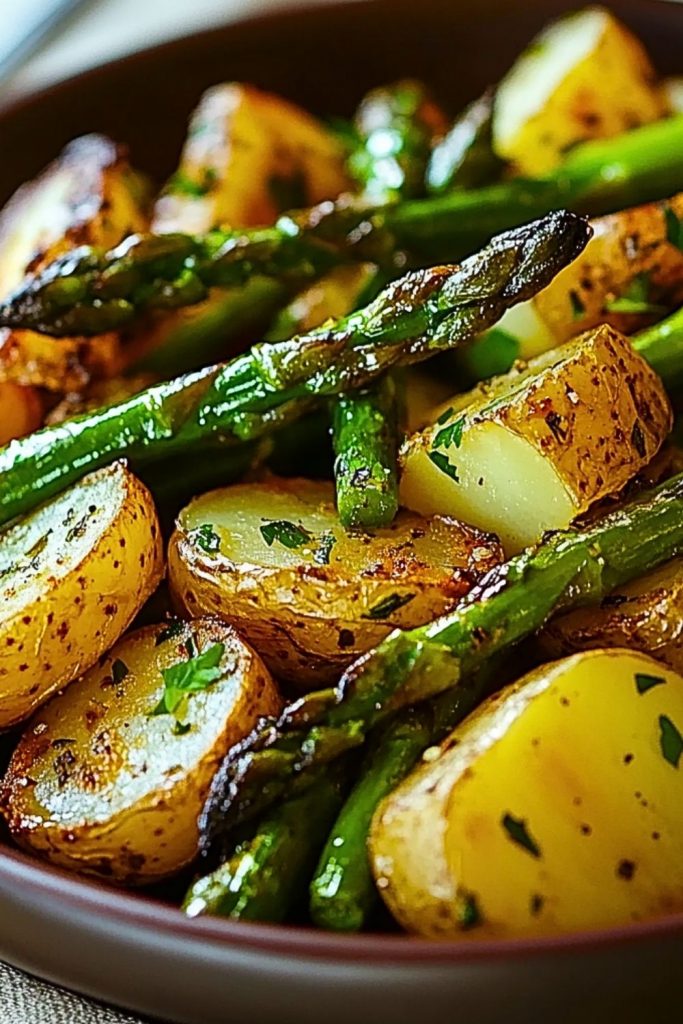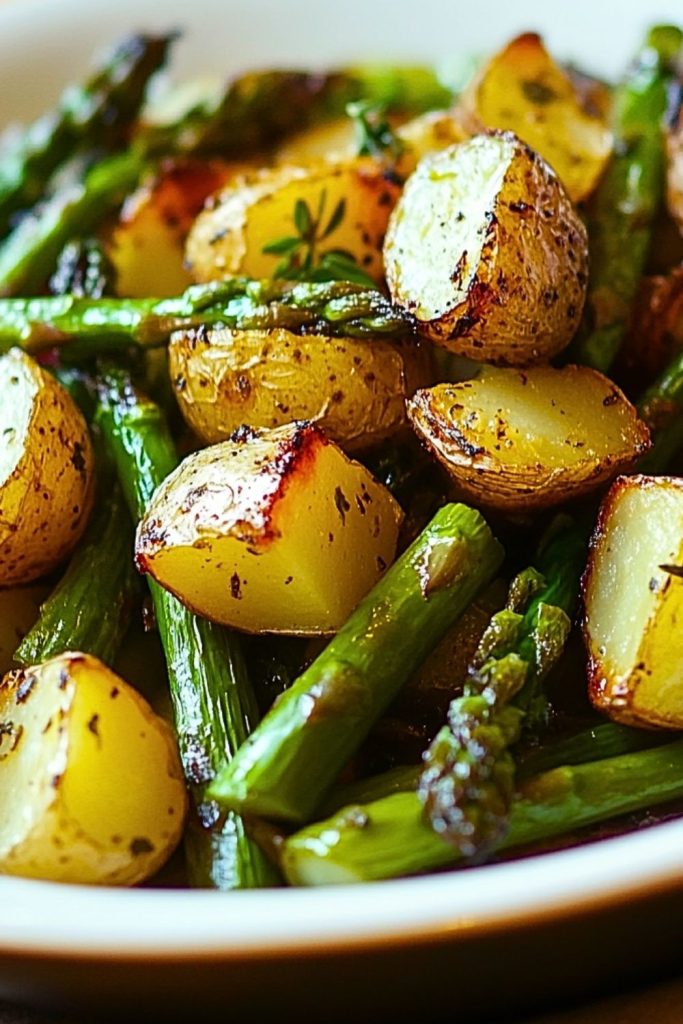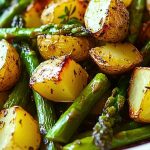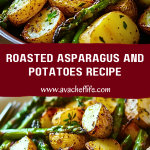Roasted Asparagus and Potatoes is one of those simple dishes I find myself returning to again and again. It’s rustic, hearty, and packed with earthy flavors that come alive with just a touch of olive oil and seasoning. I especially love how the edges of the potatoes crisp up while the asparagus stays tender with a bit of bite—creating a satisfying contrast that works beautifully as a side dish or even a main when I want something light but filling.

I first made this dish on a whim during a weeknight dinner rush, grabbing what I had in the fridge. It quickly turned into a favorite because of how effortlessly it comes together with minimal ingredients and cleanup. Whether I’m serving it with grilled meat, tossing it into a grain bowl, or pairing it with a poached egg, it never disappoints.
Why You’ll Love This Roasted Asparagus and Potatoes Recipe
This recipe hits the sweet spot between convenience and flavor. It uses affordable, everyday ingredients but results in a dish that feels gourmet. It’s naturally gluten-free, vegetarian, and full of nutrients. Plus, the versatility means it can shine at brunch, lunch, or dinner. Roasted to golden perfection, the potatoes are creamy on the inside with crispy skins, while the asparagus takes on a smoky, caramelized depth. It’s the kind of dish that doesn’t require much effort but delivers serious flavor every time.
What Kind of Potatoes and Asparagus Should I Use?
When it comes to roasting, not all vegetables are created equal. For the potatoes, I always reach for baby Yukon golds or small red potatoes. They roast beautifully, keeping a creamy texture inside while developing a golden crust on the outside. If those aren’t available, fingerlings or even standard russets cut into smaller chunks will work—just be sure to keep the pieces evenly sized for even cooking.
As for the asparagus, fresh, firm stalks are a must. I prefer medium-thick spears—they hold up better during roasting and develop a wonderful char. If you’re using very thin asparagus, you might want to add them later in the roasting process to avoid overcooking. The key is keeping the asparagus vibrant with a slight snap even after roasting.
Options for Substitutions
Sometimes you need to work with what you have, and this recipe is very forgiving:
- Potatoes: Swap in sweet potatoes for a sweeter, more nutrient-dense version. Just keep in mind they roast a bit faster.
- Asparagus: Green beans, broccolini, or even Brussels sprouts make great alternatives.
- Oil: Olive oil adds a rich flavor, but avocado oil or sunflower oil will also work for high-heat roasting.
- Herbs and Spices: Don’t have fresh herbs? Dried thyme, rosemary, or Italian seasoning can stand in. A sprinkle of garlic powder or smoked paprika also adds great depth.
- Add-ins: Toss in sliced onions, whole garlic cloves, or cherry tomatoes before roasting for added complexity.
Ingredients for This Roasted Asparagus and Potatoes Recipe
- Baby Potatoes
These are the backbone of the dish, providing heartiness and texture. Their small size helps them roast evenly and develop crisp edges. - Fresh Asparagus
Adds brightness and a tender crunch. The earthy flavor complements the potatoes perfectly and brings a nutritious green element to the plate. - Olive Oil
Essential for roasting, it helps the vegetables caramelize and enhances their natural flavor with a subtle richness. - Garlic (Minced or Crushed)
Aromatic and punchy, garlic brings a bold depth that transforms this simple dish into something more savory and satisfying. - Salt
Brings out the natural flavors of the vegetables—don’t skip it! - Black Pepper
Adds just the right amount of bite and balances the sweetness of roasted potatoes. - Fresh Herbs (Parsley, Thyme, or Rosemary)
Herbs lift the entire dish with fresh, fragrant notes. Whether tossed in before roasting or sprinkled on after, they’re an important finishing touch.

Step 1: Preheat the Oven
Set your oven to 400°F (200°C). A hot oven is crucial for roasting—it ensures crispy edges and tender centers without steaming the vegetables.
Step 2: Prepare the Vegetables
Wash the baby potatoes thoroughly, then cut them in half (or quarters if they’re larger) for quicker, even roasting. Trim the woody ends off the asparagus and leave the rest whole or cut into 2–3 inch pieces.
Step 3: Toss with Seasonings
In a large mixing bowl, combine the potatoes and asparagus. Drizzle with olive oil, add minced garlic, and season generously with salt, black pepper, and your choice of fresh herbs. Toss everything until evenly coated.
Step 4: Arrange on a Baking Sheet
Spread the vegetables out in a single layer on a large, rimmed baking sheet. Make sure they’re not crowded—use two sheets if needed. Crowding leads to steaming instead of roasting.
Step 5: Roast Until Golden
Place the baking sheet in the oven. Roast for 25–30 minutes, flipping the potatoes halfway through. If your asparagus is thinner, add it halfway through roasting to avoid overcooking.
Step 6: Garnish and Serve
Once everything is golden and crispy, remove from the oven. Let it cool for a minute, then garnish with a final sprinkle of fresh herbs or a light squeeze of lemon juice for brightness. Serve warm.
How Long to Cook the Roasted Asparagus and Potatoes
The sweet spot for roasting these veggies is 25 to 30 minutes at 400°F (200°C).
- Potatoes usually take the full 30 minutes to become tender inside with crispy, golden edges.
- Asparagus, depending on thickness, cooks a bit faster—about 15 to 20 minutes. If using thinner stalks, it’s best to add them to the baking sheet about 10 minutes after the potatoes have started roasting.
You’ll know everything’s ready when the potatoes are fork-tender and have browned at the edges, and the asparagus is slightly crisped and vibrant green.
Tips for Perfect Roasted Asparagus and Potatoes
- Cut Even Sizes
Uniformly sized potato chunks roast evenly. Avoid large chunks that might stay undercooked while the asparagus overcooks. - Use a Hot Oven
Roasting at 400°F (or even up to 425°F if you like them extra crispy) ensures proper caramelization without drying them out. - Don’t Crowd the Pan
Use a large baking sheet (or two) to keep vegetables in a single layer. Overcrowding traps steam and prevents crisping. - Toss Well with Oil
Coating every piece thoroughly with oil helps create that gorgeous, golden-brown finish. - Flip Halfway
Give the vegetables a toss or flip them halfway through roasting to ensure even cooking and browning on all sides. - Finish with Freshness
After roasting, a sprinkle of chopped fresh herbs or a squeeze of lemon juice really brightens the flavor.
Watch Out for These Mistakes While Cooking
- Adding Asparagus Too Early
Thin asparagus cooks quickly and can become stringy or mushy if roasted the entire time with potatoes. Add it halfway through unless it’s thick. - Skipping the Flip
Roasting is all about even caramelization. If you don’t toss or flip the vegetables midway, you’ll get uneven color and texture. - Using Wet Veggies
Excess moisture prevents crisping. Make sure your potatoes and asparagus are dry before tossing with oil. - Too Little Oil
Don’t skimp—oil is key for roasting. It helps with browning and brings out the natural sweetness in the vegetables. - Crowding the Pan
If everything is piled on top of each other, your veggies will steam instead of roast. Give them space!
What to Serve With Roasted Asparagus and Potatoes?
Grilled Chicken
The smokiness from the grill pairs beautifully with the caramelized vegetables for a balanced, satisfying meal.
Seared Salmon
The richness of salmon contrasts nicely with the earthy potatoes and slightly crisp asparagus.
Poached or Fried Egg
For a vegetarian option, top your roasted veg with a soft egg. The runny yolk acts like a sauce.
Quinoa or Couscous
Toss the roasted veggies into a grain bowl for an easy lunch or hearty side.
Garlic Aioli or Yogurt Sauce
Add a dollop of creamy dip or sauce on the side for a flavor boost.
Crusty Bread
Perfect for soaking up the olive oil and seasoning left on your plate.
Steak or Lamb Chops
Serve as a classic side for red meat—it’s the kind of comfort food that never goes out of style.
Storage Instructions
Roasted Asparagus and Potatoes store surprisingly well, making them perfect for meal prep or leftovers:
- Refrigerator: Store leftovers in an airtight container for up to 4 days. The potatoes may lose a bit of their crispness, but the flavor remains excellent.
- Reheating: For best results, reheat in a 375°F (190°C) oven or air fryer for 5–10 minutes to revive the crispy texture. Microwaving works too, but the veggies will be softer.
- Freezing: While technically possible, I don’t recommend it. The texture of asparagus suffers after freezing, and the potatoes can become grainy once thawed.
If you plan to make this in advance, roast the vegetables just until tender, then finish crisping them up when you reheat.
Estimated Nutrition
Here’s a rough estimate for one serving (based on a 4-serving portion size):
- Calories: ~220 kcal
- Protein: 4–5g
- Fat: 10–12g
- Carbohydrates: 28–30g
- Fiber: 4g
- Sugar: 2g
- Sodium: Depends on salt added—around 200mg
- Vitamin C & A: High, thanks to the asparagus
- Iron: Present in moderate amounts, especially from the potatoes and herbs
These values may vary slightly depending on the exact quantities and ingredients used.
Frequently Asked Questions
How do I keep the asparagus from becoming soggy?
Add the asparagus partway through roasting, especially if the stalks are thin. You can also roast them on a separate tray so you can control their cook time more easily.
Can I make this dish ahead of time?
Yes! Roast the vegetables slightly under, let them cool, and then reheat in the oven just before serving. This preserves the crisp edges without drying them out.
What herbs go best with this recipe?
Fresh rosemary, thyme, or parsley are perfect. If using dried herbs, use sparingly—a little goes a long way. Lemon zest or dill can also add a refreshing twist.
Do I need to peel the potatoes?
Nope! Baby potatoes have thin, tender skins that crisp up beautifully and add texture and nutrients. Just give them a good scrub.
Can I use frozen asparagus?
It’s not ideal. Frozen asparagus tends to release water and becomes mushy. If it’s all you have, roast it separately at a high temperature to help evaporate the moisture quickly.
What’s the best pan for roasting?
A large, rimmed baking sheet lined with parchment paper or foil works best. Avoid using glass, as it doesn’t conduct heat as evenly as metal.
How can I make this dish spicy?
Add a pinch of red pepper flakes, smoked paprika, or drizzle with chili oil before serving. A squeeze of hot sauce on the side also does the trick.
Can I add cheese to this dish?
Absolutely! Sprinkle grated Parmesan or crumbled feta over the vegetables during the last 5 minutes of roasting, or right after they come out of the oven.
Conclusion
Roasted Asparagus and Potatoes is a down-to-earth recipe that doesn’t try too hard—it just delivers. It’s the kind of dish you can make with minimal fuss, and it still feels nourishing, fresh, and comforting. Whether you’re cooking for yourself, your family, or guests, this simple combination of seasonal vegetables and savory seasoning makes for a versatile side or light main that everyone loves.

Roasted Asparagus and Potatoes
- Prep Time: 10 minutes
- Cook Time: 25 minutes
- Total Time: 35 minutes
- Yield: 4 servings
Description
Roasted Asparagus and Potatoes is a simple, wholesome dish made by oven-roasting tender baby potatoes and fresh asparagus with olive oil, garlic, and herbs. Crispy, golden, and full of natural flavor, it’s perfect as a side or a light main.
Ingredients
- 1.5 pounds baby potatoes, halved
- 1 bunch fresh asparagus, trimmed and cut if desired
- 2 tablespoons olive oil
- 3 garlic cloves, minced
- 1 teaspoon salt (adjust to taste)
- 1/2 teaspoon black pepper
- 2 tablespoons fresh herbs (parsley, thyme, or rosemary)
Instructions
- Preheat oven to 400°F (200°C).
- Wash and halve baby potatoes. Trim asparagus.
- In a large bowl, toss potatoes and asparagus with olive oil, garlic, salt, pepper, and herbs.
- Spread vegetables in a single layer on a baking sheet.
- Roast for 25–30 minutes, flipping halfway through. (If asparagus is thin, add it halfway through cooking.)
- Remove from oven and garnish with fresh herbs or lemon juice if desired. Serve warm.

